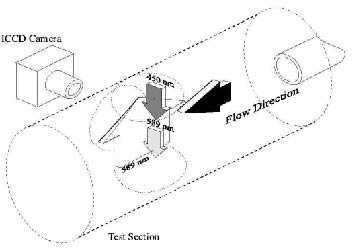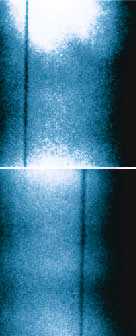Laser enhanced ionisation velocimetry (LEIV)


A novel method for measuring the velocity in high speed flows has been developed and tested by the group. The techniques works by using laser-enhanced ionisation (LEI) to ionise sodium atoms and then detecting this 'hole' using planar laser-induced fluorescence (PLIF). The atoms are ionised via a three-step process which includes excitation using two tunable dye-lasers followed by collisional ionisation. The layout is shown below. The laser beams are tightly focussed and passed through the test gas leaving a thin zone with better than 50% depletion of sodium atoms. At a short time later (of order 100-200ns), the flow is probed by a laser beam formed into a sheet tuned to the 589nm sodium atomic transition. The fluorescence is detected by a fast-gated intensified CCD camera yielding a two-dimensional image of the flow. The depleted line moves in this time reflecting the local velocity of the flow.
Initial measurements have been performed in a flame for which velocities are of the order of 5-10m/s. These tests demonstrated that the technique was viable and that high levels of depletion could be obtained.
Higher velocity flows have been examined in the small Drummond shock tube capable of generating flows of velocities around 2km/s, and in the X1 facility at speeds up to 9 km/s. Sodium was introduced into the flow upstream of the test section and freestream velocities measured. Sample images at two different delays are shown adjacent. The results agreed well with expected values. A more interesting flow was generated by inserting a small wedge into the flow and examining the velocity in the wake.